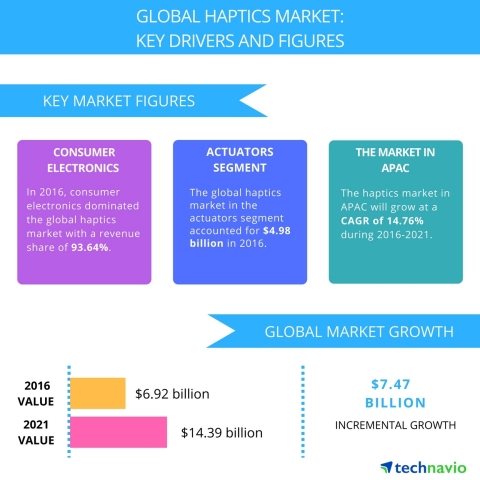LONDON--(BUSINESS WIRE)--Technavio analysts forecast the global haptics market to grow at a CAGR of close to 16% over the forecast period, according to their latest report.
The research study by Technavio on the global haptics market for 2017-2021 provides a detailed industry analysis based on the applications (smartphones, wearables, gaming consoles, and tablets), components (actuators, drivers and controllers, and software and technology), and geography (APAC, Europe, and America).
The global haptics market is monopolized by Immersion in terms of technology provider, which accounts for more than 90% of the market. The company generates revenue through licensing its patented solutions to mobile device original equipment manufacturers. Apple is another emerging vendor in the market, with its in-house haptics technology product lines such as MacBooks and iPhone 6s. The introduction of haptics by Apple in its mobile-computing devices accelerated the demand for this technology among consumer device manufacturers.
This report is available at a USD 1,000 discount for a limited time only: View market snapshot before purchasing
Buy 1 Technavio report and get the second for 50% off. Buy 2 Technavio reports and get the third for free.
Technavio analysts highlight the following three factors that are contributing to the growth of the global haptics market:
- Introduction of ultrasonic haptics technology
- Adoption of HD haptics
- Demand for interactive sensory experience
Looking for more information on this market? Request a free sample report
Technavio’s sample reports are free of charge and contain multiple sections of the report including the market size and forecast, drivers, challenges, trends, and more.
Introduction of ultrasonic haptics technology
“Ultrasonic haptics technology is an advanced form of haptics technology that enables users to touch and feel virtual objects and receive tactile feedback. Developers of the ultrasonic haptics system can deliver various haptics feedback and virtually tactile shapes via ultrasonic waves by pulsing the feedback,” explains Raghu Raj Singh, a lead analyst at Technavio for human machine interface research.
The ultrasonic haptics technology was developed by Ultrahaptics and was awarded its patent recently. This technology has found wide scope in the consumer electronics and healthcare sectors. Also, the haptics technology can be used in automobiles to improve safety by eliminating driver distraction. In fact, the company is currently working on a project with Jaguar Land Rover, which involves implementing ultrasonic haptics technology for infotainment human machine interface (HMI).
Adoption of HD haptics
The haptics technology is being incorporated in cell phones for several years, with the most basic form of haptics being the vibration of cell phone indicating an incoming call or message. A few cell phones included tactile feedback beyond vibration alerts such as the tactile feedback received by the user while messaging or typing an email. However, with advances in technology, OEMs and software application developers are moving forward to use haptics technology in mobile devices beyond basic touch feedback.
Manufacturers are integrating multiple sensory inputs in their mobile devices to create an intuitive experience for their users and software developers are developing a next-generation tactile-based application that can be run on those devices. Implementation of HD haptics provides not only highly satisfactory and intuitive experience but also solves general problems of users in day-to-day life.
Demand for interactive sensory experience
“Modern consumers demand multisensory interaction with their mobile devices. To provide a natural sense of touch to human-computer interaction, the mobile device manufacturers are adopting advanced actuator and sensors in their devices. The presence of several actuators enhances the user experience by creating vibrations synchronized with touch,” says Raghu.
For instance, when a person tries to text or dial or swipe the screen, the strength of vibration generated offers more real feedback than simple visual confirmation of the task being recorded successfully. This technology becomes more exciting for consumers using mobile devices for playing video games because while playing games, such as racing cars or playing guitars, the user has the impression of holding the car or guitar strings.
Browse Related Reports:
- Global Eye Tracking Devices Market 2017-2021
- Global Gesture Recognition for Mobile Devices Market 2017-2021
- Global Keyless Entry Systems Market 2017-2021
About Technavio
Technavio is a leading global technology research and advisory company. Their research and analysis focuses on emerging market trends and provides actionable insights to help businesses identify market opportunities and develop effective strategies to optimize their market positions.
With over 500 specialized analysts, Technavio’s report library consists of more than 10,000 reports and counting, covering 800 technologies, spanning across 50 countries. Their client base consists of enterprises of all sizes, including more than 100 Fortune 500 companies. This growing client base relies on Technavio’s comprehensive coverage, extensive research, and actionable market insights to identify opportunities in existing and potential markets and assess their competitive positions within changing market scenarios.
If you are interested in more information, please contact our media team at media@technavio.com.




